Two events from last week merged in my mind to prompt this post.
First, the Negro Leagues Baseball Museum reopened after being closed three months for the pandemic. So please put on your mask, then head down to 18th and Vine to get a baseball fix while we await the truncated MLB season.
Second, celebrated artist Kadir Nelson captured the Black Lives Matter movement with a pair of evocative covers for the New Yorker and Rolling Stone.
The connection between the Negro Leagues and Kadir Nelson dates back to 1996.
Kadir Nelson – Introduction to the Negro Leagues: When Kadir Nelson was 22 and finishing college at Pratt Institute in 1996, he was commissioned to do a painting about the Negro Leagues. During his research, he viewed Ken Burns’ 1994 documentary on baseball and became entranced with the role of the sport in the country’s history. What he found most striking was the story of the Negro Leagues which had defied daunting odds to be a community success.
Nelson: “Their spirit of independence, having made something out of nothing at all. Armed with only their intellectual and athletic talents, and the sheer will to play the game they loved so dearly, this group of men assumed control of their destiny. African Americans, rather than giving up, formed leagues of their own, successful leagues that lasted over thirty years.”
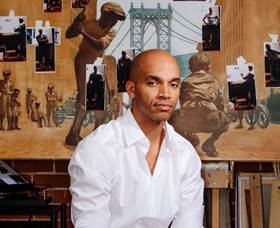
So Nelson continued to do research and paintings on the Negro Leagues. Some of his early work appeared in Sports Illustrated, and this led to many other commissions.
“Shades of Greatness”: In 2003, Nelson was one of 28 artists who came to Kansas City to attend a daylong crash course at the Negro Leagues Baseball Museum. The artists followed up with 35 original works of art that became an NLBM traveling exhibit titled “Shades of Greatness.” Nelson contributed three pieces to the exhibit, including “Willie Foster and Young Fans” (below). Foster is being followed by four kids carrying his uniform, spikes and glove, hoping to trail him into the ballpark. Buck O’Neil said the scene brought back memories: “When we played in the Negro Leagues, all the kids gathered outside the park to carry our equipment. They looked up to us, but they just wanted to get into the park for free.”
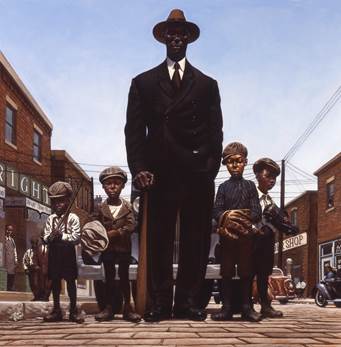
We Are The Ship: The Story of Negro League Baseball: In 2008, Nelson published We Are the Ship, a history of the Negro Leagues. The book’s title is taken from a quote by Rube Foster, the founder of the first Negro League (and half-brother of Willie, shown above with the kids). Rube said “We are the ship, all else the sea,” a reference to the fact that if the Major Leagues would not employ African Americans, they’d organize themselves. And did so in Kansas City in 1920. More on that below.
In the book, Nelson uses a fictional player, talking in a folksy vernacular, to trace the history from the beginnings in the 1920s to the ultimate decline after Jackie Robinson entered the majors. From the book jacket:
“The story of Negro League baseball is the story of gifted athletes and determined owners, of racial discrimination and international sportsmanship, of fortunes won and lost; of triumphs and defeats on and off the field. It is a perfect mirror for the social and political history of black America in the first half of the twentieth century. But most of all, the story of the Negro Leagues is about hundreds of unsung heroes who overcame segregation, hatred, terrible conditions, and low pay to do one thing they loved more than anything else in the world: play ball.”
Nelson tells an engaging story, but the big star of the book is his art. From his prolific work over a 12-year period, he chose about 50 original oil paintings to illustrate his book. It is gorgeous. Below are three examples: a team traveling on the bus (female owner Effa Manley in the right foreground), the book cover (Josh Gibson) and a safe slide into home (by Jackie Robinson who played for the Kansas City Monarchs in 1945).

Like almost everyone else watching the Ken Burns’ baseball documentary, Nelson was “quite charmed by Buck O’Neil’s recollections of the leagues. I was hooked on the leagues from then on.” The dedication page of the book has a painting of Buck (below) and his quote “Baseball got me out of that celery field.” On the acknowledgement page of the book, Nelson thanks President Bob Kendrick and Archivist Ray Doswell of the NLBM for their “tremendous generosity and support.”
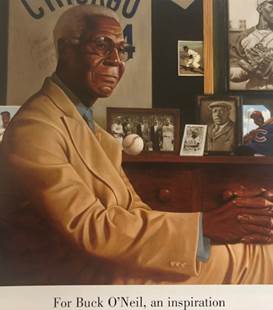
The forward to the book was written by Hank Aaron who played in the Negro Leagues before being signed by the Braves. Aaron: “Kadir’s powerful paintings eloquently bring this era to life and speak volumes about the old Negro Leagues….When I read these stories and look at the artwork, I am flooded by memories of years past and grateful for Kadir’s fresh approach to the subject. I know that I would not have made it in baseball had these legends not paved the way for me.”

One of my favorites in the book is this dugout view of the Kansas City Monarchs. The original painting is displayed at the NLBM. That’s Buck O’Neil with his foot raised to the top step. This pose may look familiar to museum regulars who have seen Buck’s statue on the Field of Legends and the mural on the Paseo YMCA.
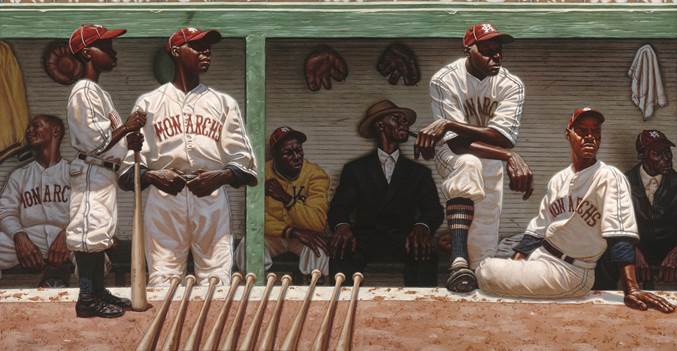
When asked in an interview about his favorite player to paint, Nelson said this:
“I loved painting all of the players, but if I had to pick one player, it would be Satchel Paige. He was tall and lanky and seemed to be always smiling inside and enjoying his life. There always seemed to be a humorous undertone with him. If I could choose another, it would be Josh Gibson. He was the epitome of what Negro Leagues baseball meant to me. Gibson represents both the triumph and the tragedy of the leagues. He was visibly strong and well equipped to play baseball on any platform, but because of the discriminative environment of Major League Baseball and the country, he was not allowed to play on the grandest stage in baseball. His is a story that represents the endless series of ‘what ifs’ that arise from discussions about the Negro Leagues.” Below, Josh in the on deck circle and Satch on the mound pitching to Buck Leonard.
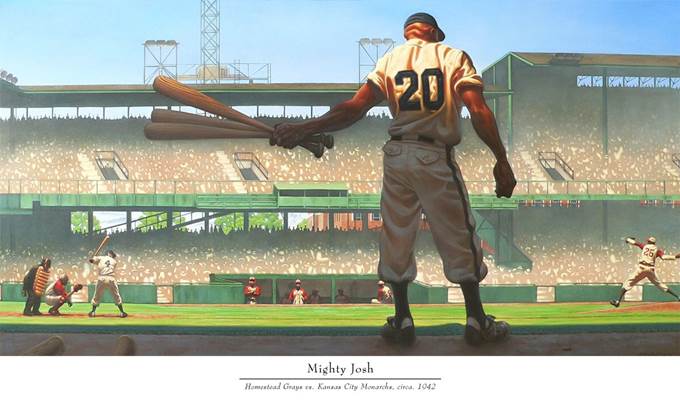
United States Postage Stamps: Kadir Nelson is also a prolific designer of U.S. postage stamps. The most relevant for this post are the two below, which were printed together, but serrated in the middle for separation into two stamps. The man on the right is Negro League founder Rube Foster. Nelson said the action scene on the left was chosen to depict the brand of fast-paced baseball that was a signature to both Rube’s preferred style of play and that of the Negro Leagues (and with a demonstrative umpire, similar to the Jackie Robinson painting above).
The first day of issuance of the stamps was in Kansas City on July 15, 2010, at a ceremony held at the Negro Leagues Baseball Museum. Among those in attendance were Kadir Nelson and Thurgood Marshall Jr., the Postal Service’s Board of Governors vice chairman.

Nelson was the artist for the All-Star series issue in 2012:
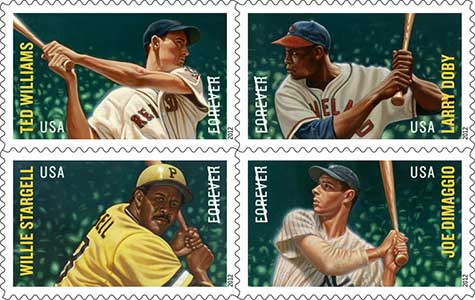
Switching sports, Nelson designed two stamps that were elongated – as needed to capture Wilt Chamberlin in a 2014 issuance.
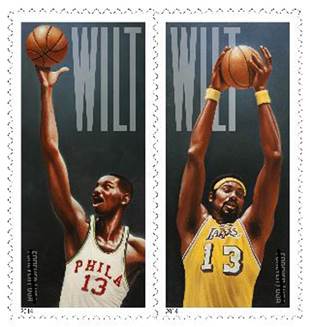
The New Yorker: Kadir Nelson’s art is ubiquitous – music album covers, a long line of children’s books, conceptual art for the movie Amistad (for Steven Spielberg), the official portrait of Rep. Shirley Chisolm that hangs in the U.S. Capitol Building, a painting of Henrietta Lacks for the Smithsonian, etc. CBS Sunday Morning did a good piece on the scope of his work in 2016 (click here, 5:01; don’t miss Sam Cooke singing while Nelson paints Muhammad Ali).
But Nelson is likely best known for his New Yorker covers. When you see one of his covers, you can name the artist. He is today’s Norman Rockwell. Click here to view a gallery of his covers. Below, “Stickball Alley.”
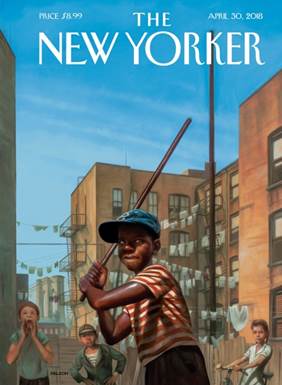
Kadir Nelson in Kansas City – 2019: Rita and I had the good fortune to meet Kadir Nelson when he was in Kansas City in June of last year. The museum was hosting an encore presentation of “Shades of Greatness” and had a reception for the artists who had contributed their works. We chatted with Nelson as we viewed his three paintings in the exhibit: “Low and Away” (below), “Willie Foster and Young Fans” and “Rube Foster.”
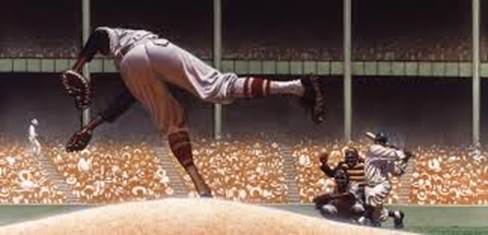
Negro Leagues 100th Anniversary – 2020: On February 13, 1920, Rube Foster established the Negro National League in a meeting of eight independent teams. The meeting was held at the Paseo YMCA in Kansas City.
On February 13, 2020, I attended a Centennial press conference at that same building, now called the Buck O’Neil Center. Speakers included NLBM President Bob Kendrick, MLB Commissioner Rob Manfred and MLB Players Association COO Xavier James. John Sherman, the new owner of the Royals, was eloquent in his remarks – here is an excerpt:
“While this story is about baseball on one hand, it is a story that transcends baseball. When I walk through the museum, I think about the courage of these people and the risks they took…Today, standing on hallowed ground, the feeling I am most left with is gratitude. Gratitude that we have this treasure with us, right here in Kansas City. Gratitude that the Negro Leagues and the Monarchs are part of our legacy, and that the Kansas City Royals have the privilege of being up close to their extraordinary history.”

The 2020 calendar for the NLBM was full of 100th Anniversary events, but many are being cancelled or rescheduled because of the pandemic. “Black Baseball in Living Color,” an exhibit that began at the museum before the pandemic shutdown, has been extended to July 19.
This coming Saturday, all MLB players were set to honor the Centennial by coming out of their dugouts and tipping their caps to the Negro Leagues – a gesture of respect for the players denied their chance to play in the majors. With baseball shut down for now, that won’t happen. But NLBM President Bob Kendrick had a “crazy idea” (his words) and recruited sportswriter Joe Posnanski to launch a “Tip Your Cap to the Negro Leagues” campaign. All baseball fans are invited to tip their caps and send a photo or video to the campaign website. For more details, see Joe’s blog post here.
Kadir Nelson is recognizing the Centennial with a Commemorative Print Edition of his painting “Down the Line.”

The Pandemic Painting: Rita and I are regular viewers of CBS Sunday Morning, and in April of this year, we saw a segment on Kadir Nelson and his painting “After The Storm.” The segment can be viewed here (4:46).
As the pandemic grew, Nelson said he wanted to produce a painting that gazed past the heavy storm clouds of the virus, moving toward the promise of a brighter and stronger future. One where the strength of human spirit and challenges of all humankind stand together. He also said “I think one of the things that we’re probably missing, a lot of people are missing now, is human touch, because we have to stay so far away from one another. So, I wanted to make sure to emphasize that that is part of being a human being, is human touch.”
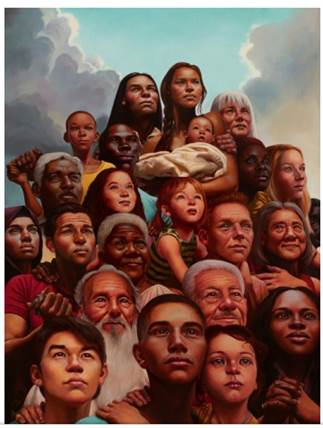
But before the pandemic could even show signs of receding, another tragedy took the headlines and demanded new paintings.
Black Lives Matter Covers: Nelson has been there before, notably in We Are the Ship, which illuminated the systemic racism that kept baseball segregated until 1947. Unfortunately, the integration of baseball did not mean the end of systemic racism. Not even close. Nor did the Civil Rights Acts or the election of Barack Obama. Racism is a persistent evil. That’s why it is necessary to have a Black Lives Matter movement and why Nelson painted this stunning New Yorker cover. It is titled “Say Their Names.” The magazine has posted an annotated version to identify many of the faces (click here).
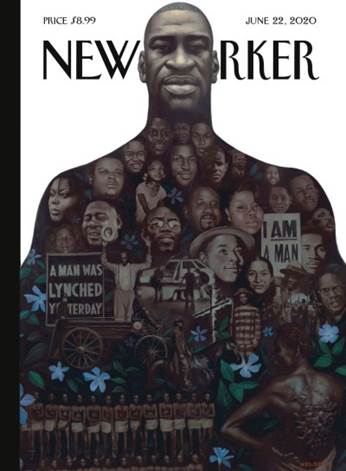
Nelson also provided the cover art for the current issue of Rolling Stone. The magazine envisioned a hopeful and inspirational cover, and Nelson said he immediately thought of Eugène Delacroix’s “Liberty Leading the People,” the iconic 1830 painting that depicts a woman leading the French Revolution. “I wanted to create something in a similar vein that would have the same feeling and celebrate this tipping point in our history.”
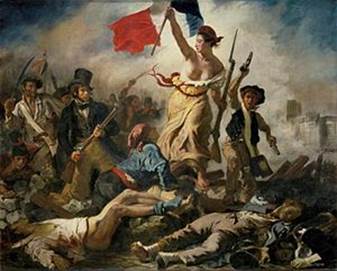
He also wanted to honor the women of the Black Lives Matter movement. “They are very much at the forefront in spearheading this change, so I thought it was very important for an African American woman to be at the very center of this painting, because they have very much been at the center of this movement. I want everyone in this painting — particularly the African American women and children — to know that they matter. That they have the power to create change in the world. This painting is to honor, celebrate them and to inspire them to continue doing what they’re doing, because what they’re doing is important work.”
Rolling Stone has posted a video of Nelson working on the painting and discussing the content (click here; 4:05).
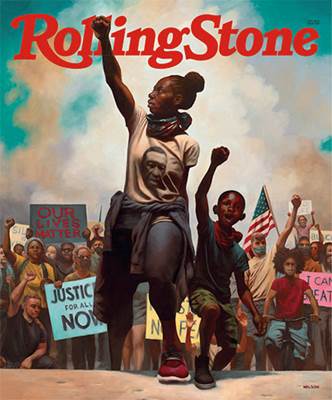
Lonnie’s Jukebox – Da 5 Bloods: To set the stage for Lonnie’s Jukebox, I’m going to feature two more paintings by Kadir Nelson: (i) a portrait of Marvin Gaye that graces a postage stamp, and (ii) a unique look at Muhammad Ali.

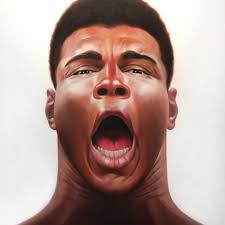
Gaye and Ali play supporting roles in the new Spike Lee movie now streaming on Netflix: Da 5 Bloods. Rita and I give the movie two thumbs up! See the trailer here.
The film follows four African American veterans who return to Vietnam some 45 years after the war. One of the story lines is how black soldiers grapple with why they fought so hard for a country that does not fully value them. Lee weaves in historical footage of past events, including an eloquent Muhammad Ali who refused induction into the army in 1966. Among Ali’s statements back then:
“Why should they ask me to put on a uniform and go 10,000 miles from home and drop bombs and bullets on Brown people in Vietnam while so-called Negro people in Louisville are treated like dogs and denied simple human rights?…If I thought the war was going to bring freedom and equality to 22 million of my people they wouldn’t have to draft me, I’d join tomorrow. I have nothing to lose by standing up for my beliefs. So I’ll go to jail, so what? We’ve been in jail for 400 years.”
Like Ali, Marvin Gaye wanted to speak to the issues facing African Americans. In his words:
“In 1969 or 1970, I began to re-evaluate my whole concept of what I wanted my music to say … I was very much affected by letters my brother was sending me from Vietnam, as well as the social situation here at home. I realized that I had to put my own fantasies behind me if I wanted to write songs that would reach the souls of people. I wanted them to take a look at what was happening in the world.”
Although they may not have used the same wording, Ali and Gaye were fighting systemic racism five decades ago.
In 1971, Gaye recorded “What’s Going On,” a song originally written by Obie Benson of the Four Tops and Al Cleveland. The inspiration for their “protest” song came from Benson having witnessed police brutality and violence at a 1969 anti-war protest at Berkeley. Gaye had been looking for the right song to go with his concern over the “world exploding” and the conversations he was having with his brother serving in Vietnam. Gaye revised and retitled the song, and his record became a big hit.
“What’s Going On” is a perfect fit for Da 5 Bloods. Five other songs by Gaye are on the soundtrack, including “What’s Happening Brother,” dedicated to Spike’s brother Frankie in Vietnam.
To listen, click on the titles: “What’s Going On” and “What’s Happening Brother.” If you would like to dig deeper into the soundtrack, click here.
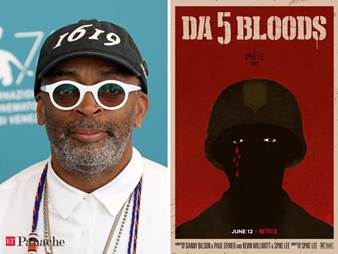
[Spike Lee Movie Trivia: Lee’s 1989 movie Do the Right Thing was dedicated to six victims of police or racial brutality. In the movie, Radio Raheem is killed when a policeman refuses to release a chokehold. Like Eric Garner (2014). Like George Floyd (2020). Lee tweeted a video of clips intercut to show the similarity of the three killings. I’ll not include the link – it’s hard to watch.]
[Spike/Kadir Trivia: Spike Lee saw some of Kadir Nelson’s early work in Sports Illustrated and became a buyer of Nelson paintings. Spike and his wife Tony wrote a pair of children’s books (Please, Baby, Please and Please, Puppy, Please). Kadir Nelson is the illustrator for both.]
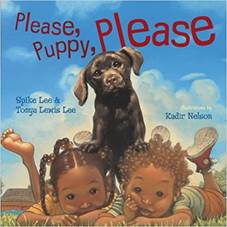
[Music Trivia: The four military veterans in the Da 5 Bloods are named Melvin, Paul, Eddie and Otis. The son of one of the veterans joins them on the trip – his name is David. Spike Lee was having some fun. That’s the five first names of the “Classic Five” lineup of the Temptations.]
Bonus Tracks: Before the pandemic hit, one of the most popular shows on Broadway was “Ain’t Too Proud,” a jukebox musical featuring the songs of the Temptations. It’s a delight. While the theater is dark for the pandemic, let’s go back to some original recordings from the group: “My Girl,” “Just My Imagination” and “I Can’t Get Next To You.”
[For Hot Stove archives, click here.]